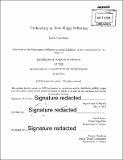Preheating in new Higgs inflation
Author(s)
Guardado, Karla (Karla M.)
DownloadFull printable version (2.808Mb)
Other Contributors
Massachusetts Institute of Technology. Department of Physics.
Advisor
David Kaiser.
Terms of use
Metadata
Show full item recordAbstract
Cosmological inflation describes the phenomenon in the early universe when spacetime underwent a rapid, exponential expansion right after the Big Bang. Inflation solves the so-called "horizon problem," "flatness problem," and "monopole problem" of standard Big Bang cosmology. Furthermore, New Inflation solves the "graceful exit problem" of the original theory. In inflation, the energy density of a patch of the early universe becomes dominated by the potential energy of a scalar field in a state of false vacuum. This particular form of energy leads to a negative pressure, creating a repulsive gravitational force, driving the region into a period of exponential expansion. Soon after the end of inflation, the field oscillates, leading to the creation of particles in a process called reheating. If reheating begins with parametric resonance, the process is called preheating. New Higgs Inflation presumes that the Higgs field is the scalar field in question, involving a characteristic non-minimal "derivative" coupling. The equation of motion for the field evolves like a damped harmonic oscillator, so we expect it to oscillate near the end of inflation. We study the dynamics of the Higgs field during and after inflation and find that preheating should be efficient in this model.
Description
Thesis: S.B., Massachusetts Institute of Technology, Department of Physics, 2015. Cataloged from PDF version of thesis. Includes bibliographical references (pages 37-38).
Date issued
2015Department
Massachusetts Institute of Technology. Department of PhysicsPublisher
Massachusetts Institute of Technology
Keywords
Physics.